Why Scissor Lift Rental is Essential for Modern Work Sites
Scissor lift rental provides businesses with flexible access to liftd work platforms without the high upfront costs of purchasing equipment. Here's what you need to know:
Key Scissor Lift Rental Benefits:
- Daily rates: $150-$495 depending on height and model
- Weekly discounts: Up to 60% savings over daily rates
- Monthly options: $680-$2,960 for extended projects
- Delivery included: Most rental companies provide jobsite delivery
- No maintenance: Rental company handles repairs and servicing
- Latest models: Access to newest safety features and technology
Popular Rental Categories:
- Electric scissor lifts (19-40 ft) for indoor use
- Rough terrain models (26-70 ft) for outdoor construction
- Narrow vs wide platforms based on workspace needs
- Slab lifts for smooth concrete surfaces only
Whether you're handling warehouse maintenance, construction work, or facility upgrades, scissor lift rental offers the flexibility to match equipment precisely to your project duration and requirements. The average daily rental cost of $272 in major markets makes it cost-effective for most short-term applications.
As American Mortuary Coolers, we've worked extensively with lifting equipment across funeral home operations and understand how scissor lift rental can provide reliable access solutions without the burden of equipment ownership. Our experience with mortuary lifting systems has shown us the importance of choosing the right equipment for specific operational needs.
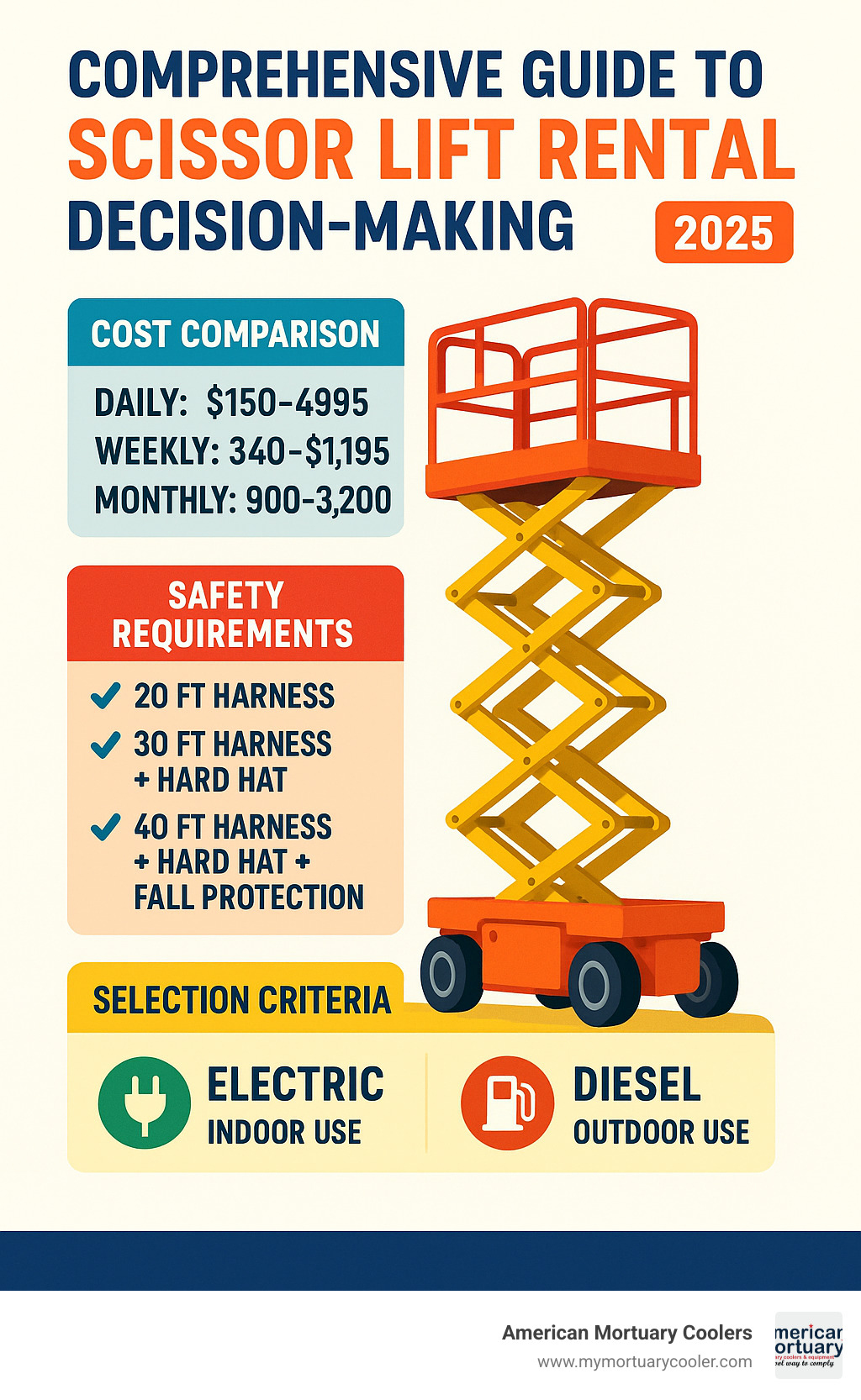
Simple scissor lift rental glossary:
How Scissor Lifts Work & Key Types
When you're considering scissor lift rental, understanding the mechanics makes all the difference in choosing the right equipment. Picture an accordion - that's essentially how scissor lifts work. The clever pantograph mechanism uses a series of linked supports that fold and unfold in a scissor-like motion.
Hydraulic actuators power most scissor lifts, though electric models use battery-powered systems. The operator controls everything from a simple platform-mounted box with selector dials, emergency stops, and joystick steering.
OSHA classifies scissor lifts as "mobile scaffolding" when they only move up and down. But the moment they can move horizontally while lifted, they become "aerial lifts." This distinction matters for safety training and regulations.
The scissor mechanism's biggest advantage is stability. Unlike boom lifts that extend outward, scissor lifts keep their center of gravity directly over the base, making them perfect for detailed work.
| Feature | Electric Scissor Lifts | Diesel Scissor Lifts |
|---|---|---|
| Best Use | Indoor, quiet environments | Outdoor construction, rough terrain |
| Emissions | Zero emissions | Exhaust fumes |
| Noise Level | Whisper quiet | Moderate engine noise |
| Height Range | 10-40 feet | 20-70 feet |
| Capacity | 500-1,000 lbs | 1,000-1,500 lbs |
| Terrain | Smooth, level surfaces | Slopes, gravel, uneven ground |
Electric & Hybrid Models
Electric scissor lifts are the workhorses of indoor scissor lift rental. The zero-fumes operation makes electric models perfect for enclosed spaces, while these battery-powered units run quietly enough for normal conversations.
Non-marking tires protect expensive polished floors. The typical 500-pound capacity handles two workers plus tools comfortably on most 19-foot models.
Electric scissor lifts offer height ranges from 10 to 40 feet working height. The 19-foot model remains most popular because it fits through standard doorways while providing 25 feet of working height when you factor in operator reach.
Battery runtime typically lasts 6-8 hours on a full charge - perfect for a full workday.
More info about electric scissor lifts
Diesel & Rough-Terrain Options
When your project moves outdoors or terrain gets challenging, diesel and rough-terrain scissor lifts become essential. These rugged machines handle conditions that would strand electric models.
4WD capability lets these powerhouses handle slopes, soft ground, and uneven surfaces. High ground clearance means they roll over debris and obstacles that would stop other equipment.
Rough-terrain models reach up to 70 feet of working height with heavy-duty capacity of up to 1,500 pounds. Pothole guards protect the base from ground hazards, while all-weather operation keeps projects moving when conditions would ground other equipment.
At American Mortuary Coolers, we understand how the right lifting equipment can make or break a project. Whether installing mortuary equipment or handling facility maintenance, choosing between electric and diesel scissor lift rental options depends entirely on your specific environment and requirements.
Pros & Cons of Scissor Lift Rental vs Purchase
Deciding between scissor lift rental and buying equipment can feel overwhelming. Most businesses find rental works better than expected - let's walk through both sides so you can make the right choice.
Advantages of Scissor Lift Rental
The biggest win with scissor lift rental is avoiding hefty upfront costs. New scissor lifts run $15,000 to $75,000 or more, which is serious money for most businesses. When you rent, that money stays in your bank account for core operations.
No storage headaches might be the second-best benefit. These machines take up real space, and finding secure storage isn't always easy. With rental, equipment shows up when needed and disappears when you don't.
You get access to latest models without constantly upgrading your fleet. Safety features improve yearly, and rental companies maintain newer equipment than what you'd buy and keep for a decade.
Delivery is usually included in rental agreements, saving transport hassles. Most rental companies handle drop-off and pickup at your job site.
Maintenance savings matter too. When something breaks on a rental, one phone call gets it fixed or replaced. No hunting for parts, no repair bills, no downtime.
Disadvantages of Scissor Lift Rental
The main downside is availability limits during busy construction seasons. Spring and summer can get tight, especially for popular models like 19-foot electric lifts.
Cumulative costs can sneak up too. Daily rates seem reasonable but add up fast on longer projects. If you're using lifts consistently throughout the year, purchasing might make more financial sense.
Contract restrictions can be frustrating. Most rental agreements limit what you can do with equipment, and some companies are strict about modifications.
When Is Scissor Lift Rental the Smart Choice?
Scissor lift rental shines for short-term projects - anything under six months usually favors rental. For seasonal demand with long periods where equipment would sit unused, rental makes perfect sense.
The trial-before-buy approach works great too. Rent different models to see what works for your operations before committing to purchase.
Generally, if you'll use equipment less than 60% of the time, rental typically beats buying.
At American Mortuary Coolers, we've seen this decision play out across many funeral homes. Most find scissor lift rental gives them exactly what they need without ownership headaches, especially for occasional maintenance and renovation projects.
Choosing the Right Scissor Lift for Your Job
Picking the perfect scissor lift feels a bit like choosing the right tool from a well-stocked toolbox - you need to match the equipment to your specific job requirements. Getting this decision right can make the difference between a smooth project and unnecessary headaches.
The key is asking yourself three critical questions: How high do I need to reach? How much weight will I be carrying? And where exactly will I be working?
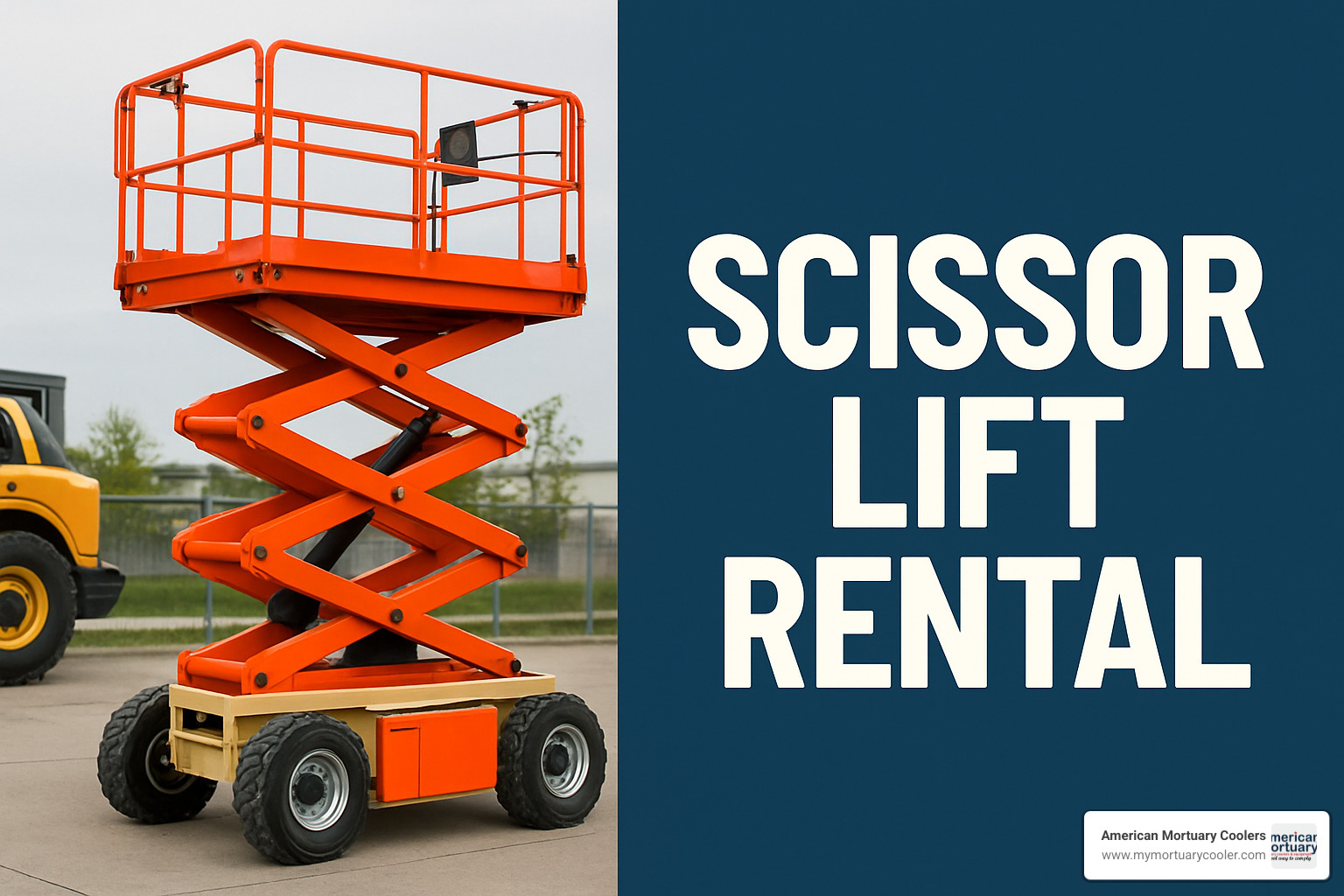
Match Height & Reach
Here's something that trips up many first-time renters: working height isn't the same as platform height. When you're standing on the platform with your arms extended, you can reach about 6 feet higher than the platform itself.
This matters more than you might think. A 19-foot platform actually gives you 25 feet of working height - perfect for most standard ceiling work and warehouse maintenance tasks.
For bigger jobs, you'll want to step up accordingly. A 26-foot platform reaches 32 feet total, which handles most warehouse applications beautifully. Need to go higher? A 32-foot platform gets you to 38 feet working height for industrial maintenance work.
When you're dealing with large facilities or multi-story buildings, 40-foot platforms provide 46 feet of working height. And for those really ambitious exterior projects, rough terrain models can stretch all the way up to 70 feet - though at that point, you're definitely in specialized territory.
Capacity & Personnel Limits
Every scissor lift rental comes with strict weight limits and personnel restrictions that aren't just suggestions - they're OSHA requirements that keep everyone safe.
Most compact electric lifts handle 500 pounds and 2 people maximum. That might sound like plenty, but a typical worker with tools weighs around 200-250 pounds. Add in materials, and you're closer to capacity than you'd expect.
Standard electric lifts bump up to 750 pounds and can accommodate 2-3 people, while large electric models max out at 1,000 pounds for 3-4 workers. If you're tackling outdoor construction, rough terrain lifts are the heavy hitters with 1,500-pound capacity and room for 4-6 people.
Always do the math before you head up. Account for every person, every tool, and every material that's going on that platform. It's better to overestimate and stay safe than to push limits and create dangerous situations.
Environment & Power Source
Your work environment practically chooses your power source for you. Electric scissor lifts shine indoors where emissions rules matter, noise limits exist, and you're working on smooth surfaces. They're perfect for warehouses, retail spaces, hospitals, and anywhere people are trying to work or shop while you're up there.
Battery runtime typically gives you 6-8 hours of operation, which covers most single-shift work. Plus, those non-marking tires won't leave scuffs on finished floors - something facility managers definitely appreciate.
Diesel and rough-terrain options take over when you head outdoors. These machines handle slopes, mud, gravel, and all the challenging terrain that would stop an electric model cold. They're built for construction sites where fuel refill beats battery charging for extended runtime.
Doorway clearance becomes crucial for indoor work. Most standard scissor lifts fit through regular doorways, but always measure twice and rent once. Nothing's more frustrating than having a lift delivered that won't fit through your building entrance.
An Essential Guide to American Mortuary Coolers Scissor Lifts
At American Mortuary Coolers, we've learned that choosing the right lifting equipment - whether for mortuary operations or general construction - comes down to matching capabilities with real-world requirements. The same terrain assessment and height calculations that matter for construction sites apply to our specialized mortuary lifting solutions. Scientific research on OSHA fall protection reinforces how critical proper equipment selection is for worker safety across all industries.
Safety, Regulations & Maintenance Essentials
When it comes to scissor lift rental, safety isn't just important—it's legally required and essential for protecting your team. OSHA has specific requirements every operator must follow.
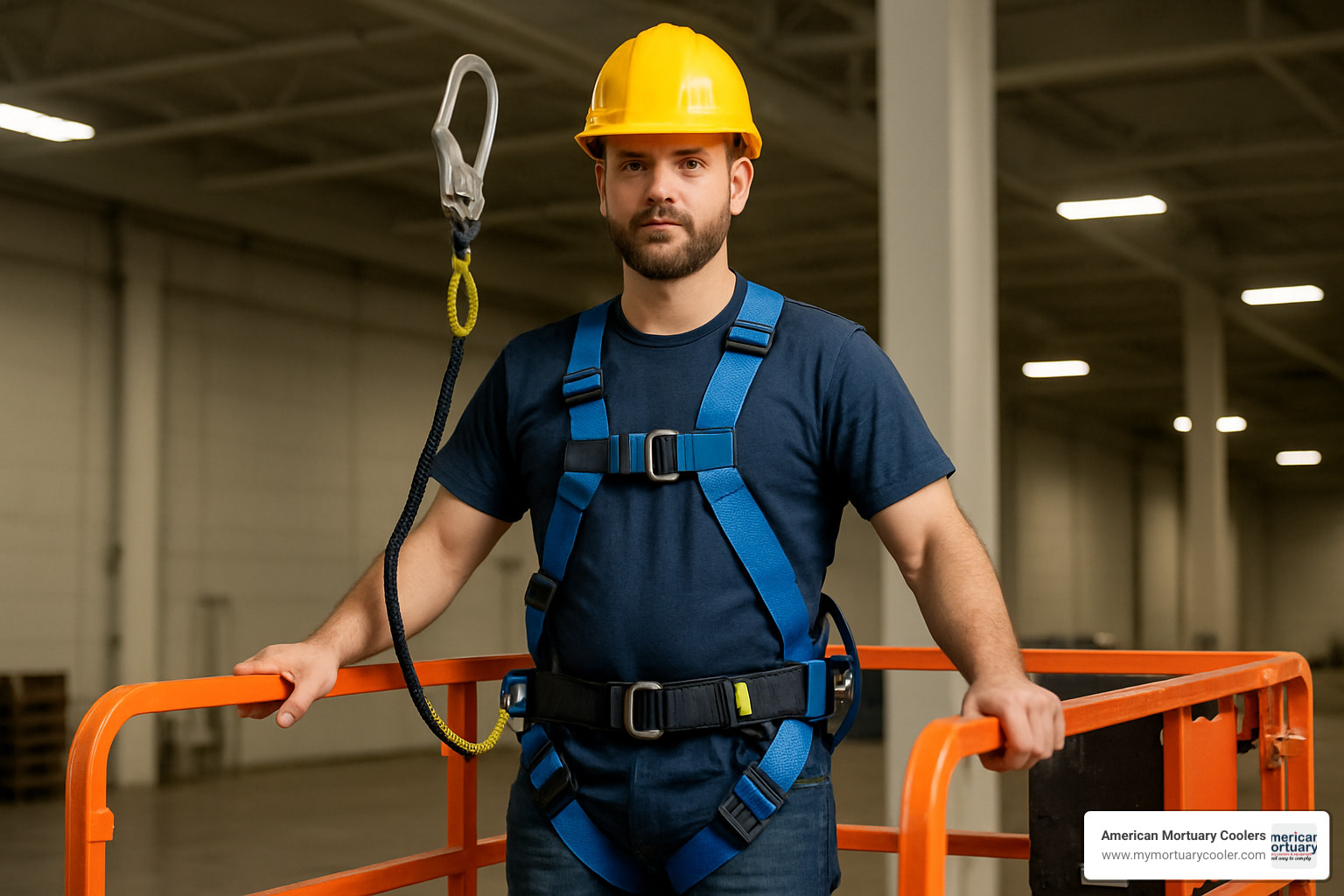
Before anyone steps onto that platform, a thorough pre-use inspection is mandatory. This daily checklist covers: battery charge levels for electric models, hydraulic fluid levels and potential leaks, tire condition and proper pressure, platform guardrails with secure gates, and testing emergency lowering systems. Verify all controls respond smoothly and check for obvious damage.
The ANSI A92.24 standard governs scissor lift operations. Every component from tire integrity to guardrails must meet specific requirements. The emergency lowering system must be tested and functional daily.
Operator Training & Compliance
OSHA requires proper training for scissor lift operators, though specific certification requirements vary by location and industry.
Essential training covers job briefing procedures, where supervisors explain specific hazards for each work site. Each location requires its own hazard analysis based on terrain, weather, nearby power lines, and site-specific dangers.
Fall protection rules are critical. In general industry, you need fall protection above 4 feet. In construction, that's 6 feet. You must use a full-body harness attached to designated anchor points on the scissor lift itself. Never attach your harness to adjacent structures.
Scientific research on OSHA fall protection
Maintaining a Rented Lift On-Site
One great thing about scissor lift rental is that rental companies handle major maintenance and repairs. But daily care keeps everyone safe and prevents costly breakdowns.
Battery charging is critical for electric models—don't wait until the battery dies mid-project. Check hydraulic fluid levels regularly and watch for leaks. Debris removal might seem minor, but accumulated materials can interfere with safety systems.
The service call process with your rental company should be straightforward. Most reputable companies offer 24/7 support and quickly replace malfunctioning equipment. Know your rental company's emergency contact information.
Watch for warning signs like unusual noises, jerky operation, or any safety system that doesn't work perfectly. When in doubt, stop work and call for service.
At American Mortuary Coolers, we've seen how proper maintenance and safety protocols protect both equipment and people across all lifting applications. The same attention to detail in our custom mortuary equipment applies to any lifting situation—safety first, always.
Costs, Rental Rates & Booking Process
Let's talk money - because understanding scissor lift rental pricing helps you make smart decisions for your project budget. The good news? Rental rates are pretty straightforward once you know what affects the cost.
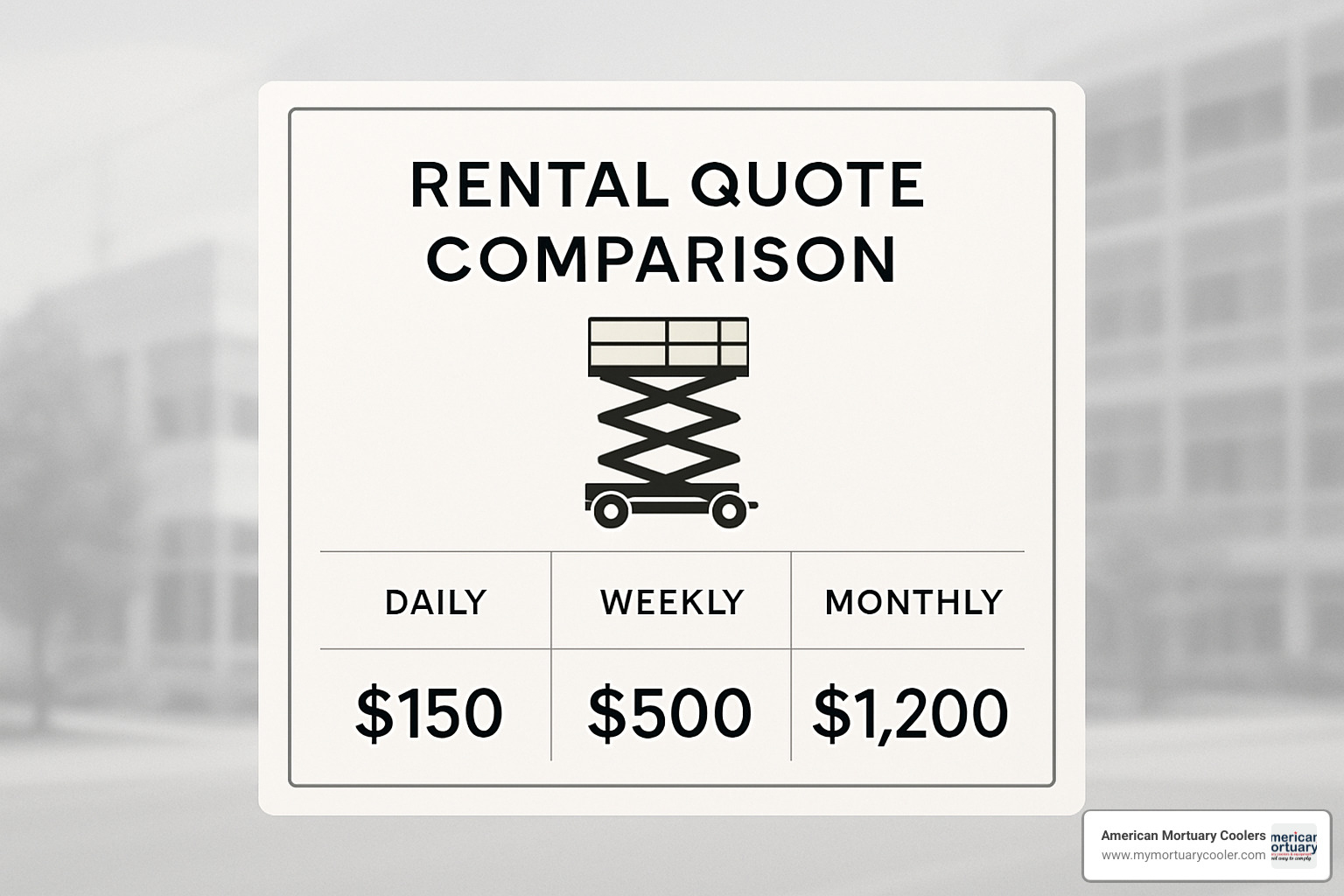
The biggest factor in pricing? Height. The higher you need to go, the more you'll pay. But here's the thing - the weekly and monthly discounts are where you really save money. If your project runs longer than a few days, those extended rates become your best friend.
Typical Scissor Lift Rental Pricing Tiers
Here's what you can expect to pay for scissor lift rental in most markets:
Electric models (perfect for indoor work) start reasonable and climb with height. A 13-foot electric lift runs about $150 per day, but drops to just $375 for the whole week - that's real savings right there. The popular 19-foot model hits $175 daily or $425 weekly, while the 26-foot workhorse costs $255 daily but only $535 for seven days.
When you need serious height, a 32-foot electric lift runs $285 daily or $650 weekly. The big 40-foot models jump to $350 daily, but the weekly rate of $800 still beats paying daily if you need it for more than two days.
Rough terrain models cost more because they're built tougher. A 26-foot rough terrain unit starts at $275 daily or $675 weekly. The 32-foot models run $325 daily, and those impressive 40-foot units hit $425 per day. The really tall 50+ foot models can reach $495 daily, but remember - these machines can do work that nothing else can.
Monthly rates offer the best value for extended projects. That same 19-foot electric lift that costs $175 daily? It's only $800 for the entire month. Even the big 40-foot models drop to $1,900 monthly - a huge savings over daily rates.
Don't forget the extra costs though. Delivery and pickup typically add $75-$150 each way, and most companies charge small environmental fees. Many contractors opt for damage protection plans that cost about 8-12% of the rental - cheap insurance for expensive equipment.
Step-by-Step Rental Process
Renting a scissor lift is simpler than you might think, but there are a few steps to get right.
Start with the basics - figure out exactly what height you need and whether you're working indoors or outdoors. This determines whether you need electric or diesel power. Most rental companies have helpful staff who can guide you through the options.
The paperwork part comes next. You'll need to complete a credit application and provide your business license and insurance certificate. Don't worry - this is standard stuff, and most companies make it easy with online applications. They'll also need a valid driver's license for anyone operating the equipment.
Booking your dates is crucial, especially during busy construction seasons. Reserve your equipment as early as possible, and be specific about delivery times. Most companies are flexible, but popular models can book up fast.
When delivery day arrives, take a few minutes to inspect the equipment with the delivery driver. They'll show you the basic controls and safety features - pay attention, because this quick training can prevent problems later. Make sure everything looks good before signing the delivery receipt.
During your rental period, treat the equipment well. Those daily inspections we talked about earlier? They're not just for safety - they protect you from damage charges too. If something goes wrong, call the rental company immediately. Most offer 24/7 support because they know downtime costs you money.
Return is usually straightforward - just clean off the mud and debris, and be honest about any issues. Most rental companies understand that equipment gets used hard, and they'd rather hear about problems than find them later.
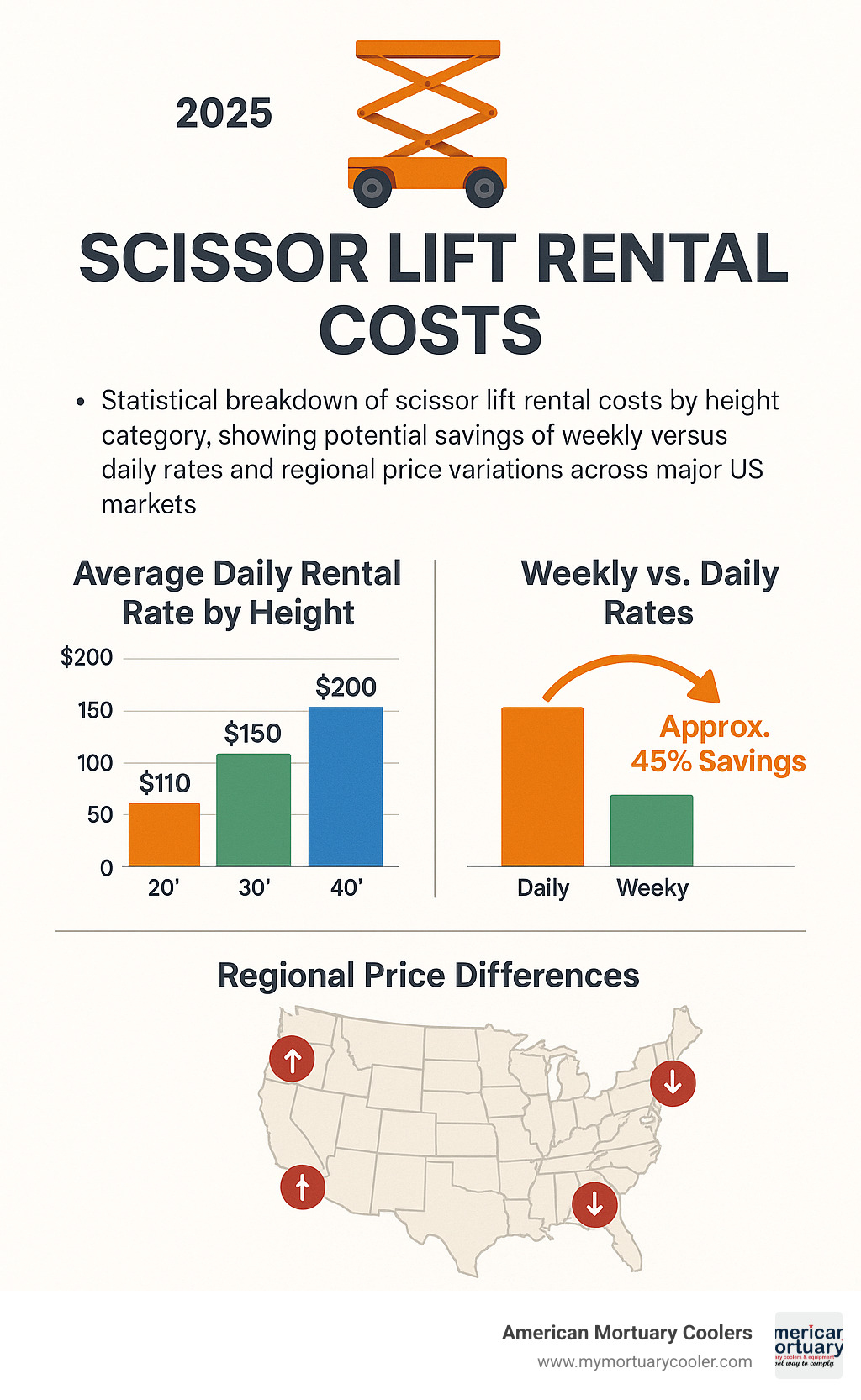
At American Mortuary Coolers, we understand how important reliable equipment is for specialized work. Just like our custom mortuary equipment needs to perform flawlessly when it matters most, your scissor lift rental should give you confidence to focus on the job at hand, not worry about equipment failure.
Frequently Asked Questions about Scissor Lift Rental
When you're considering scissor lift rental for the first time, it's natural to have questions. These are the most common concerns we hear from customers across all industries, including our work with funeral homes and mortuary facilities.
What's the difference between a scissor lift and a boom lift?
Think of it this way: scissor lifts go straight up like an elevator, while boom lifts swing out like a crane arm. The scissor mechanism creates an incredibly stable platform that stays directly over the base - perfect when you need a rock-steady work surface for detailed tasks.
Boom lifts (sometimes called cherry pickers) can reach up and over obstacles, making them great for tree work or getting around building features. But that flexibility comes with more sway and movement. If you're doing precision work, installing fixtures, or need to carry heavier materials, the scissor lift rental option usually wins hands down.
We've seen this choice matter a lot in funeral home renovations - when you're installing delicate lighting or working on detailed ceiling work, that extra stability makes all the difference.
Do I need fall protection on a scissor lift rental?
Yes, absolutely. OSHA doesn't mess around with fall protection requirements, and neither should you. The rules are straightforward: you need fall protection above 4 feet in general industry settings and 6 feet on construction sites.
Here's what that means practically: you must wear a full-body harness that connects to the designated anchor points built into the scissor lift platform. These anchor points are specifically engineered for your safety - never, ever attach your harness to nearby structures like ceiling beams or adjacent equipment.
Why? If the lift moves unexpectedly while you're tied to something else, the forces involved can cause serious injury. The rental company should provide or help you source proper fall protection gear, and most offer quick training on correct usage.
How far in advance should I reserve a scissor lift rental?
For most routine jobs, 2-3 days advance notice works fine. But like many things in life, timing matters a lot. Spring and summer bring peak construction season, which means equipment gets scarce and prices can jump.
If you need something specific - say, a 40-foot electric model for indoor work - or you're in a busy market like Nashville or Atlanta, bump that up to 1-2 weeks ahead. Specialty equipment always books faster.
Emergency rentals? They're usually possible, but you'll pay extra and might have to take whatever's available rather than the perfect fit for your job. We always tell our mortuary clients to plan ahead when possible - it saves money and ensures you get exactly what you need for those critical facility upgrades.
The rental companies we work with are pretty good about accommodating rush jobs, but advance planning makes everyone's life easier and keeps your project on budget.
Conclusion
Scissor lift rental has become the go-to solution for smart businesses who need liftd access without breaking the bank. Starting at just $150 per day, these rentals offer incredible flexibility - and when you factor in weekly or monthly discounts, the savings really add up for longer projects.
The secret to getting the most from your scissor lift rental experience? Match the machine to your mission. That quiet electric model works beautifully for indoor warehouse tasks, while those tough diesel units power through outdoor construction challenges like champs. Height, weight limits, power source, terrain - get these factors right, and your project runs like clockwork.
Here at American Mortuary Coolers, we've spent years perfecting lifting solutions across Tennessee, Georgia, Illinois, and beyond. While our specialty lies in custom mortuary coolers and funeral industry equipment, we understand how the right lifting equipment transforms any operation. Whether it's installing our cooling systems or handling delicate mortuary equipment, proper lifting solutions make all the difference between smooth operations and costly headaches.
Safety never takes a holiday when you're working at height. Proper training, quality fall protection gear, and those daily inspections aren't just good ideas - they're your lifeline. The good news? Rental companies stand behind their equipment with round-the-clock support, so help is always just a phone call away.
Scissor lift rental gives you something precious in today's business world: flexibility without commitment. Try different models, scale up for big projects, scale down for maintenance work - all while accessing the latest safety technology. No storage headaches, no maintenance nightmares, no obsolescence worries.
With competitive pricing in every major market and nationwide delivery making equipment accessible anywhere, there's never been a better time to lift your next project with a rental solution that actually makes sense.
















